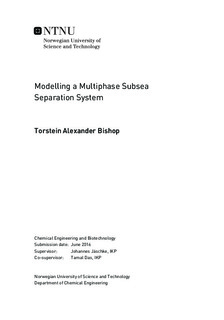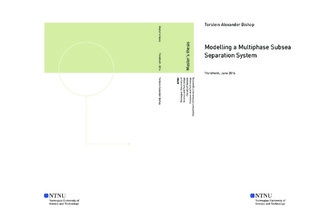| dc.description.abstract | With the oil and gas industry changing rapidly and new oil-fields becoming less accessible, the demand for new technology and innovative thinking is increasing. With these challenges in mind a possible solution could be to further exploit the possibilities that lies within subsea processing and separation. In this thesis the main objective has been to develop a model for a Gas-Liquid Cylindrical Cyclone separator (GLCC-separator) for control and optimization purposes.
The model for the GLCC-Separator was created by splitting the separator into three parts; an inlet area, an upper part of the separator and a lower part of the separator. The inlet area determines the composition of the inlet flow to the separator by using an entrainment correlation, while the upper and lower part determines the separator performance. The models estimating the separator performance are based on an average droplet/bubble velocity estimated by the centrifugal and drag forces by assuming Stokes' law.
The GLCC performance was not validated with experimental data, but was tested against varying flow rates and inlet gas volume fractions in order to get a tentative understanding of how these factors affect the separation performance. The GLCC was then combined with a deliquidizer model to form a separation system. This system was optimized for inlet gas fractions and flow rates, with respect to the gas fraction in the outlet gas stream and the oil fraction in the outlet oil stream. The optimization variable was the ratio between the product streams of the deliquidizer.
The results from the simulations show that the performance of the GLCC is highly dependent on the inlet gas volume fraction and the inlet flow rate. High flow rates and inlet gas volume fractions around 0.5 were found to yield poor performance. The simulations also revealed that the entrainment model overestimates the entrainment of gas into the liquid stream at certain combinations of inlet gas fractions and flow rates, thus reducing the operational boundaries of the model. It was also revealed that the entrainment model removed the possibility to explicitly control the outlet flow streams of the separator, which can make control and optimization problematic. The optimization of the separation system did however show that the deliquidizer manage to yield acceptable values for the gas fraction in the outlet gas stream and the oil fraction in the outlet oil stream. | |

